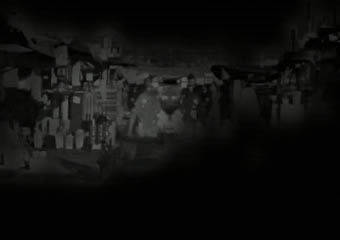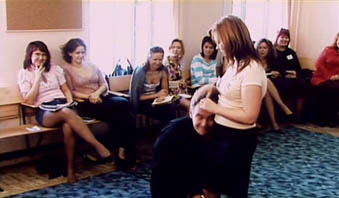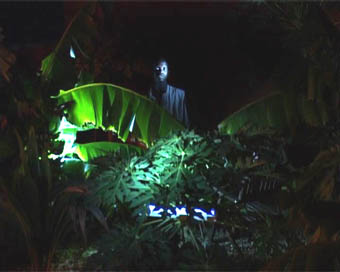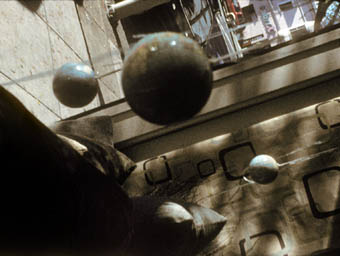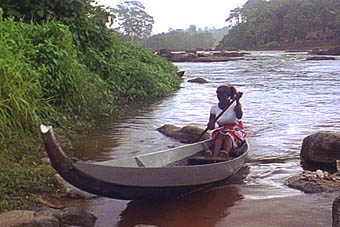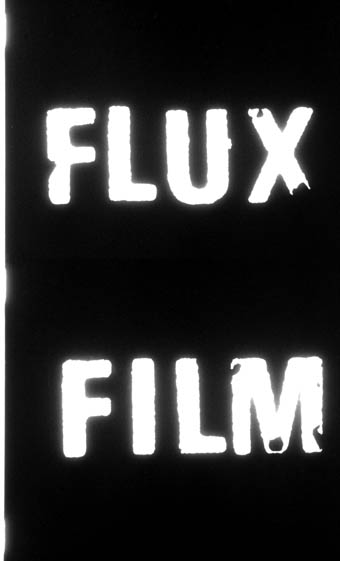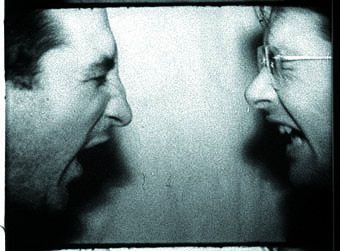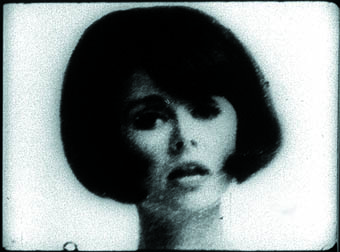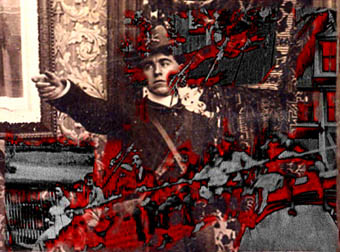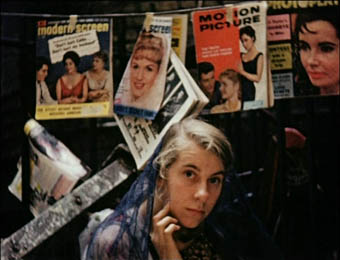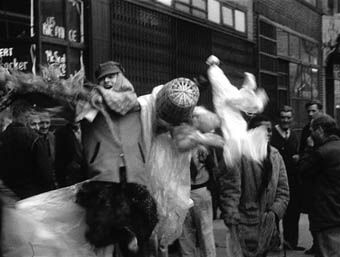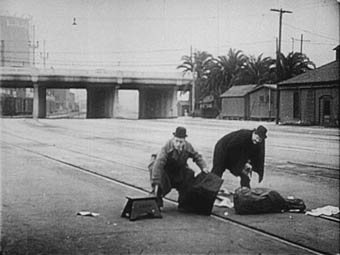London Film Festival 2008
LONDON FILM FESTIVAL: ARTISTS' FILM & VIDEO
London BFI Southbank
25-26 October 2008
The festival’s annual celebration of artists’ film and video will take place on 25-26 October 2008, presenting a diverse selection of international work in eight screenings that open a window onto a wide range of creativity.
This year’s selection includes special programmes devoted to the work of Nathaniel Dorsky, Alina Rudnitskaya, Ben Rivers and Michel Auder. Films by the radical French theorist Guy Debord will be shown in 35mm preservation prints. New approaches to documentary and ethnography recur throughout the weekend, which presents established and emerging artists in a curated survey of innovation in the moving image. Several makers will be present to discuss their work and two continuous installations will be shown in the BFI Southbank Studio.
Curated by Mark Webber for The Times BFI 52nd London Film Festival.
PLEASE NOTE: More tickets for "sold out" screenings may be released in the days leading up to the weekend & there are usually a few available on the door immediate before each programme.
Saturday 25 October 2008, from 12-7pm, Studio, FREE
PNEUMA MONOXYD
PNEUMA MONOXYD
Thomas Köner | Germany-Serbia 2007 | 10 min (continuous loop)
Merging surveillance images of a German shopping street and a Balkan marketplace, Köner’s darkly abstract work, with its spatially evocative soundtrack, generates a muted sense of spectral dystopia.
Saturday 25 October 2008, at 2pm, NFT3
A SENSE OF PLACE
FOUR TORONTO FILMS
Nicky Hamlyn | UK 2007 | 18 min
During a residency in the Canadian city, Hamlyn made this suite of films that explore a direct relationship between subject matter and camera apparatus. Three scrutinise aspects of the urban locale, the other an accelerated view of Koshlong Lake.
21 ALLEYS
Robert Todd | USA 2007 | 9 min
A residential street, seen through the passageways that separate its dwellings, is the focus of this understated study of gentrification in a Boston neighbourhood.
LOSSLESS #2
Rebecca Baron, Douglas Goodwin | USA 2008 | 3 min
Witness the dematerialization of an avant-garde standard as incomplete digital files, downloaded from file sharing networks, induce trouble in the image.
TRILOGY: KETTLE’S YARD
Jayne Parker | UK 2008 | 25 min
Linear Construction, Woman with Arms Crossed and Arc refer back to a quartet of films made with musician Anton Lukoszevieze almost a decade ago. This new anthology for solo cello was shot at Kettles Yard and incorporates items from the museum’s collection which open up metaphorical space and meaning.
THE MIRACLE OF DON CRISTOBAL
Lawrence Jordan | USA 2008 | 12 min
An alchemical melodrama composed of engravings from 19th century adventure stories. The illustrations are conjured into motion as improbable sounds collide with a Puccini aria.
Total running time approximately 90 min
Saturday 25 October 2008, at 4pm, NFT3
GUY DEBORD
‘The cinema, too, has to be destroyed.’ (Guy Debord)
An extremely rare opportunity to see new 35mm prints of films by French writer and theorist Guy Debord, best known for The Society of the Spectacle. Debord was a central figure of the Situationist International (SI), a nihilistic band of agitators whose harsh critiques of capitalist society, inspired by Marxism and Dada, were conveyed through publications, visual art and collective actions. Articulated primarily in the French language, Situationism was relatively ineffective in Britain and America in its time, and though numerous translations are now available, Debord’s radical films remain unseen. Far ahead of its time, his technique of ‘détournement’ assimilates still and moving image-scraps from features, newsreels, printed matter, advertisements and other detritus to satisfy the viewer’s ‘pathetic need’ for cinematic illusion. Propelled by a spoken, monotonous discourse, the images do not so much illustrate the text as underpin it, often maintaining a metaphorical relationship that may not at first be apparent. The two films showing here effectively bookend Debord’s involvement with the Situationists, whose politically subversive practice aspired to provoke a revolution of everyday life.
SUR LE PASSAGE DE QUELQUES PERSONNES À TRAVERS UNE ASSEZ COURTE UNITÉ DE TEMPS
Guy Debord | France 1959 | 18 min
In the dingy bars of St-Germain-des-Prés, Debord and his associates formed a bohemian underground for whom ‘oblivion was their ruling passion.’ This anti-documentary captures the SI close to its moment of inception, following their separation from the Lettristes two years prior.
IN GIRUM IMUS NOCTE ET CONSUMIMUR IGNI
Guy Debord | France 1978 | 105 min
‘I will make no concessions to the public in this film. I believe there are several good reasons for this decision, and I am going to state them.’ And state them he does. Debord’s final film is a denunciation of cinema and society at large, an unremitting diatribe against consumption. The SI is equated to a military operation (charge of the light brigade, no less) as its members are presented alongside images of the D-Day landings, Andreas Baader, Zorro, a comic strip Prince Valliant and quotes from Shakespeare, Ecclesiastes and Omar Khayyám. Debord takes no prisoners in this testament to his anarchistic vision.
Total running time approximately 125 min
Saturday 25 October 2008, at 7pm, NFT3
ALINA RUDNITSKAYA
Alina Rudnitskaya’s humanistic approach to documentary filmmaking often brings out the humour in her chosen subjects. As an introduction to her work, this programme depicts three diverse groups of contemporary Russian women.
AMAZONS
Alina Rudnitskaya | Russia 2003 | 20 min
A sensitive portrait of an unusual urban phenomenon: a troupe of independent and strong-minded girls who keep horses in the heart of St Petersburg. Amazons follows a new volunteer as she tries to find her place within the group dynamic.
BESAME MUCHO
Alina Rudnitskaya | Russia 2006 | 27 min
With music providing an escape from their duties as veterinarians, nurses and cleaners, the amateur chorus of a provincial town rehearse songs from Verdi’s ‘Aida’. Close bonds are formed, but in true diva style, relationships within the choir are frequently inharmonious.
BITCH ACADEMY
Alina Rudnitskaya | Russia 2008 | 29 min
An improbable symbol of modern Russia is displayed in this tragicomic verité on the aspirations of young women. In a progressive twist on assertiveness training, a middle-aged, paunchy Casanova (who surely loves his job) gives classes on how to seduce the male using role play, styling critiques and sexy dancing. The ultimate goal is to hitch a millionaire, and though there’s much humour in the situation, occasional tears and telling looks remind us that the insecurities of real lives are being laid bare.
Total running time approximately 80 min
Saturday 27 October 2008, at 9pm, NFT3
WHEN LATITUDES BECOME FORM
IN THE KINGDOM OF SHADOWS
Francisca Duran | Canada 2006 | 6 min
Set in metal type, a passage from Maxim Gorky’s review of the Lumières melts into a pool of molten lead.
HOW TO CONDUCT A LOVE AFFAIR
David Gatten | USA 2007 | 8 min
‘An unexpected letter leads to an unanticipated encounter and an extravagant gift. Some windows open easily; other shadows remain locked rooms.’ (David Gatten)
THE PARABLE OF THE TULIP PAINTER AND THE FLY
Charlotte Pryce | USA 2008 | 4 min
A saturated cine-miniature inspired by Dutch 17th Century painting.
DEEP SIX
Sami van Ingen | Finland 2007 | 7 min
The film image of a loaded truck, careening free of its position in the frame, speeds along a mountain road towards an inevitable fate.
DE TIJD
Bart Vegter | Netherlands 2008 | 9 min
Computer animated abstraction in three dimensions. Slowly evolving geometric forms suggest sculptural figures and waning shadows.
HORIZONTAL BOUNDARIES
Pat O’Neill | USA 2008 | 23 min
O’Neill’s dizzying deployment of the 35mm frame-line is intensified by Carl Stone’s electronic score. A hard and rhythmic work, thick with superimposition, contrary motion and volatile contrasts, reminiscent of his pioneering abstract work of prior decades.
EASTER MORNING
Bruce Conner | USA 2008 | 10 min
Bruce Conner’s freewheeling camera chases morning light in a hypnotic blur of colour and multiple exposures. This final work by the artist and filmmaker rejuvinates his rarely seen 8mm film Easter Morning Raga (1966). With music by Terry Riley.
Total running time approximately 70 min
Sunday 28 October 2008, from 12-7pm, Studio, FREE
KEMPINSKI
KEMPINKSI
Neil Beloufa | Mali-France 2007 | 14 min (continuous loop)
Whilst challenging our stereotypical view of Africa, Kempinksi also blurs the lines between documentary, ethnography and science fiction. Asked to imagine the future but to speak in the present tense, the protagonists describe extraordinary and unexpected visions.
Sunday 26 October 2008, at 2pm, NFT3
NATHANIEL DORSKY IN PERSON
In his search for a ‘polyvalent’ mode of filmmaking, Nathaniel Dorsky has developed a filmic language which is intrinsic and unique to the medium, and expressive of human emotion. Seeking wonder not only in nature but in the everyday interaction between people in the metropolitan environment, Dorsky observes the world around him. Free of narrative or theme, his films transcend daily reality and open a space for introspective thought. ‘Delicately shifting the weight and solidity of the images’, a deeper sense of being is manifest in the interplay between film grain and natural light. Dorsky returns to London to introduce two brand new films and Triste, the work that first intimated his sublime and distinctive ‘devotional cinema’. These lyric films are humble offerings which unassumingly blossom on the screen, illuminating a path for vision.
WINTER
Nathaniel Dorsky | USA 2007 | 19 min
‘San Francisco’s winter is a season unto itself. Fleeting, rain-soaked, verdant, a brief period of shadows and renewal.’ (Nathaniel Dorsky)
SARABANDE
Nathaniel Dorsky | USA 2008 | 15 min
‘Dark and stately is the warm, graceful tenderness of the sarabande.’ (Nathaniel Dorsky)
TRISTE
Nathaniel Dorsky | USA 1978-96 | 19 min
‘Triste is an indication of the level of cinema language that I have been working towards. By delicately shifting the weight and solidity of the images, and bringing together subject matter not ordinarily associated, a deeper sense of impermanence and mystery can open. The images are as much pure-energy objects as representation of verbal understanding and the screen itself is transformed into a ‘speaking’ character. The ‘sadness’ referred to in the title is more the struggle of the film itself to become a film as such, rather than some pervasive mood.’ (Nathaniel Dorsky)
Total running time approximately 70 min
Sunday 26 October 2008, at 3:45pm, NFT3
Tuesday 28 October 2008, at 7pm, Studio
THE FEATURE
THE FEATURE
Michel Auder, Andrew Neel | USA 2008 | 177 min
In Michel Auder’s case, the truth is certainly stranger than fiction. One of the first to compulsively exploit the diaristic potential of the Sony Portapak, he was right there at the heart of the Warhol Factory and the Soho art explosion. This fictionalised biography draws on his vast archive of videotapes, connecting them by means of a distanced narration and new footage, shot by co-director Andrew Neel, in which Auder portrays his doppelganger, an arrogantly successful artist who may or may not have a life-threatening condition. Resisting nostalgia through wilful ambiguity, The Feature remains raw and brutally honest as Auder displays the best and worst of himself. Taking in his marriages to both Viva and Cindy Sherman, and affiliations with Larry Rivers, the Zanzibar group and the downtown art scene, this is necessarily a tale of epic proportions, chronicling an amazing journey through art and life whilst providing access to a wealth of fascinating personal footage.
Sunday 26 October 2008, at 7pm, NFT3
THE WORD FOR WORLD IS FOREST
SMALL MIRACLES
Julia Hechtman | USA 2006 | 5 min
Sci-fi hallucinations seem commonplace as Hechtman invokes mysterious natural phenomena: an extreme case of mind over matter.
KEMPINSKI
Neil Beloufa | Mali-France 2007 | 14 min
Speaking in the present tense, interviewees describe their idiosyncratic notions of the future. To the western viewer, the unlikely subjects, stylized settings and atmospheric lighting impart a strange disconnect between science fiction and anthropology.
TJÚBA TÉN (THE WET SEASON)
Brigid McCaffrey, Ben Russell | USA-Suriname 2008 | 47 min
‘An experimental ethnography composed of community-generated performances, re-enactments and extemporaneous recordings, this film functions doubly as an examination of a rapidly changing material culture in the present and as a historical document for the future. Whether the record is directed towards its subjects, its temporary residents (filmmakers), or its Western viewers is a question proposed via the combination of long takes, materialist approaches, selective subtitling, and a focus on various forms of cultural labour.’ (Ben Russell)
REMOTE INTIMACY
Sylvia Schedelbauer | Germany 2008 | 15 min
Cast adrift in the collective unconscious, Remote Imtimacy constructs an allegorical collage from found footage and biographical fragments, exploring cultural dislocation using the rhetoric of dreams.
Sunday 26 October 2008, at 9pm, NFT3
BEN RIVERS AT THE EDGE OF THE WORLD
An intrepid explorer, Ben Rivers toys with ethnographic tropes whilst roaming free from documentary truth. Encountering those who choose to live apart from society, his nonjudgmental approach presents ‘real life, or something close to it.’ The Edge of the World features several recent works with other films of his choice.
AH LIBERTY!
Ben Rivers | UK 2008 | 19 min
In the wilderness of a highland farm, a bunch of tearaways joyride, smash up, tinker and terrorize the way that only children can. Assimilating landscape and livestock, this poetic study contrasts the languid setting with the youngster’s restless energy.
RECORDANDO EL AYER
Alexandra Cuesta | USA 2007 | 9 min
Utilitarian objects, related to health and hygiene, rendered in unconventional ways. This unsettling film questions the way that we relate to our surroundings by exploring the ‘radical otherness’ of things.
ASTIKA
Ben Rivers | UK-Denmark 2007 | 8 min
Danish recluse Astika has allowed nature to run wild, overgrowing his own habitat to the point that he has no option but to move away. The film is a hazy arrangement in green and gold, all rich textures and lush foliage.
SINGING BISCUITS
Luther Price | USA 2007 | 4 min
A gospel cry rings out across the decades, disrupted in space and time, fading but resilient.
NEW SURPRISE FILM
Ben Rivers | UK 2008 | c.7 min
A little anticipation never did anyone any harm; you’ll have to be there to find out what it is.
ORIGIN OF THE SPECIES
Ben Rivers | UK 2008 | 17 min
‘A 70-year old man living in a remote part of Scotland has been obsessed with ‘trying to really understand’ Darwin’s book for many years. Alongside this passion, he’s been constantly working on small inventions for making his life easier. The film investigates someone profoundly interested in human beings, but who has decided to live separately from the majority of them.’ (Ben Rivers)
Total running time approximately 75 min
…
Advance booking recommended
Standard ticket price is £8.50
Book online at www.bfi.org.uk/lff
Telephone Box Office: 020 7928 3232
Book in person at BFI Southbank
For full booking info see www.bfi.org.uk/lff
London BFI Southbank
25-26 October 2008
The festival’s annual celebration of artists’ film and video will take place on 25-26 October 2008, presenting a diverse selection of international work in eight screenings that open a window onto a wide range of creativity.
This year’s selection includes special programmes devoted to the work of Nathaniel Dorsky, Alina Rudnitskaya, Ben Rivers and Michel Auder. Films by the radical French theorist Guy Debord will be shown in 35mm preservation prints. New approaches to documentary and ethnography recur throughout the weekend, which presents established and emerging artists in a curated survey of innovation in the moving image. Several makers will be present to discuss their work and two continuous installations will be shown in the BFI Southbank Studio.
Curated by Mark Webber for The Times BFI 52nd London Film Festival.
PLEASE NOTE: More tickets for "sold out" screenings may be released in the days leading up to the weekend & there are usually a few available on the door immediate before each programme.
Saturday 25 October 2008, from 12-7pm, Studio, FREE
PNEUMA MONOXYD
PNEUMA MONOXYD
Thomas Köner | Germany-Serbia 2007 | 10 min (continuous loop)
Merging surveillance images of a German shopping street and a Balkan marketplace, Köner’s darkly abstract work, with its spatially evocative soundtrack, generates a muted sense of spectral dystopia.
Saturday 25 October 2008, at 2pm, NFT3
A SENSE OF PLACE
FOUR TORONTO FILMS
Nicky Hamlyn | UK 2007 | 18 min
During a residency in the Canadian city, Hamlyn made this suite of films that explore a direct relationship between subject matter and camera apparatus. Three scrutinise aspects of the urban locale, the other an accelerated view of Koshlong Lake.
21 ALLEYS
Robert Todd | USA 2007 | 9 min
A residential street, seen through the passageways that separate its dwellings, is the focus of this understated study of gentrification in a Boston neighbourhood.
LOSSLESS #2
Rebecca Baron, Douglas Goodwin | USA 2008 | 3 min
Witness the dematerialization of an avant-garde standard as incomplete digital files, downloaded from file sharing networks, induce trouble in the image.
TRILOGY: KETTLE’S YARD
Jayne Parker | UK 2008 | 25 min
Linear Construction, Woman with Arms Crossed and Arc refer back to a quartet of films made with musician Anton Lukoszevieze almost a decade ago. This new anthology for solo cello was shot at Kettles Yard and incorporates items from the museum’s collection which open up metaphorical space and meaning.
THE MIRACLE OF DON CRISTOBAL
Lawrence Jordan | USA 2008 | 12 min
An alchemical melodrama composed of engravings from 19th century adventure stories. The illustrations are conjured into motion as improbable sounds collide with a Puccini aria.
Total running time approximately 90 min
Saturday 25 October 2008, at 4pm, NFT3
GUY DEBORD
‘The cinema, too, has to be destroyed.’ (Guy Debord)
An extremely rare opportunity to see new 35mm prints of films by French writer and theorist Guy Debord, best known for The Society of the Spectacle. Debord was a central figure of the Situationist International (SI), a nihilistic band of agitators whose harsh critiques of capitalist society, inspired by Marxism and Dada, were conveyed through publications, visual art and collective actions. Articulated primarily in the French language, Situationism was relatively ineffective in Britain and America in its time, and though numerous translations are now available, Debord’s radical films remain unseen. Far ahead of its time, his technique of ‘détournement’ assimilates still and moving image-scraps from features, newsreels, printed matter, advertisements and other detritus to satisfy the viewer’s ‘pathetic need’ for cinematic illusion. Propelled by a spoken, monotonous discourse, the images do not so much illustrate the text as underpin it, often maintaining a metaphorical relationship that may not at first be apparent. The two films showing here effectively bookend Debord’s involvement with the Situationists, whose politically subversive practice aspired to provoke a revolution of everyday life.
SUR LE PASSAGE DE QUELQUES PERSONNES À TRAVERS UNE ASSEZ COURTE UNITÉ DE TEMPS
Guy Debord | France 1959 | 18 min
In the dingy bars of St-Germain-des-Prés, Debord and his associates formed a bohemian underground for whom ‘oblivion was their ruling passion.’ This anti-documentary captures the SI close to its moment of inception, following their separation from the Lettristes two years prior.
IN GIRUM IMUS NOCTE ET CONSUMIMUR IGNI
Guy Debord | France 1978 | 105 min
‘I will make no concessions to the public in this film. I believe there are several good reasons for this decision, and I am going to state them.’ And state them he does. Debord’s final film is a denunciation of cinema and society at large, an unremitting diatribe against consumption. The SI is equated to a military operation (charge of the light brigade, no less) as its members are presented alongside images of the D-Day landings, Andreas Baader, Zorro, a comic strip Prince Valliant and quotes from Shakespeare, Ecclesiastes and Omar Khayyám. Debord takes no prisoners in this testament to his anarchistic vision.
Total running time approximately 125 min
Saturday 25 October 2008, at 7pm, NFT3
ALINA RUDNITSKAYA
Alina Rudnitskaya’s humanistic approach to documentary filmmaking often brings out the humour in her chosen subjects. As an introduction to her work, this programme depicts three diverse groups of contemporary Russian women.
AMAZONS
Alina Rudnitskaya | Russia 2003 | 20 min
A sensitive portrait of an unusual urban phenomenon: a troupe of independent and strong-minded girls who keep horses in the heart of St Petersburg. Amazons follows a new volunteer as she tries to find her place within the group dynamic.
BESAME MUCHO
Alina Rudnitskaya | Russia 2006 | 27 min
With music providing an escape from their duties as veterinarians, nurses and cleaners, the amateur chorus of a provincial town rehearse songs from Verdi’s ‘Aida’. Close bonds are formed, but in true diva style, relationships within the choir are frequently inharmonious.
BITCH ACADEMY
Alina Rudnitskaya | Russia 2008 | 29 min
An improbable symbol of modern Russia is displayed in this tragicomic verité on the aspirations of young women. In a progressive twist on assertiveness training, a middle-aged, paunchy Casanova (who surely loves his job) gives classes on how to seduce the male using role play, styling critiques and sexy dancing. The ultimate goal is to hitch a millionaire, and though there’s much humour in the situation, occasional tears and telling looks remind us that the insecurities of real lives are being laid bare.
Total running time approximately 80 min
Saturday 27 October 2008, at 9pm, NFT3
WHEN LATITUDES BECOME FORM
IN THE KINGDOM OF SHADOWS
Francisca Duran | Canada 2006 | 6 min
Set in metal type, a passage from Maxim Gorky’s review of the Lumières melts into a pool of molten lead.
HOW TO CONDUCT A LOVE AFFAIR
David Gatten | USA 2007 | 8 min
‘An unexpected letter leads to an unanticipated encounter and an extravagant gift. Some windows open easily; other shadows remain locked rooms.’ (David Gatten)
THE PARABLE OF THE TULIP PAINTER AND THE FLY
Charlotte Pryce | USA 2008 | 4 min
A saturated cine-miniature inspired by Dutch 17th Century painting.
DEEP SIX
Sami van Ingen | Finland 2007 | 7 min
The film image of a loaded truck, careening free of its position in the frame, speeds along a mountain road towards an inevitable fate.
DE TIJD
Bart Vegter | Netherlands 2008 | 9 min
Computer animated abstraction in three dimensions. Slowly evolving geometric forms suggest sculptural figures and waning shadows.
HORIZONTAL BOUNDARIES
Pat O’Neill | USA 2008 | 23 min
O’Neill’s dizzying deployment of the 35mm frame-line is intensified by Carl Stone’s electronic score. A hard and rhythmic work, thick with superimposition, contrary motion and volatile contrasts, reminiscent of his pioneering abstract work of prior decades.
EASTER MORNING
Bruce Conner | USA 2008 | 10 min
Bruce Conner’s freewheeling camera chases morning light in a hypnotic blur of colour and multiple exposures. This final work by the artist and filmmaker rejuvinates his rarely seen 8mm film Easter Morning Raga (1966). With music by Terry Riley.
Total running time approximately 70 min
Sunday 28 October 2008, from 12-7pm, Studio, FREE
KEMPINSKI
KEMPINKSI
Neil Beloufa | Mali-France 2007 | 14 min (continuous loop)
Whilst challenging our stereotypical view of Africa, Kempinksi also blurs the lines between documentary, ethnography and science fiction. Asked to imagine the future but to speak in the present tense, the protagonists describe extraordinary and unexpected visions.
Sunday 26 October 2008, at 2pm, NFT3
NATHANIEL DORSKY IN PERSON
In his search for a ‘polyvalent’ mode of filmmaking, Nathaniel Dorsky has developed a filmic language which is intrinsic and unique to the medium, and expressive of human emotion. Seeking wonder not only in nature but in the everyday interaction between people in the metropolitan environment, Dorsky observes the world around him. Free of narrative or theme, his films transcend daily reality and open a space for introspective thought. ‘Delicately shifting the weight and solidity of the images’, a deeper sense of being is manifest in the interplay between film grain and natural light. Dorsky returns to London to introduce two brand new films and Triste, the work that first intimated his sublime and distinctive ‘devotional cinema’. These lyric films are humble offerings which unassumingly blossom on the screen, illuminating a path for vision.
WINTER
Nathaniel Dorsky | USA 2007 | 19 min
‘San Francisco’s winter is a season unto itself. Fleeting, rain-soaked, verdant, a brief period of shadows and renewal.’ (Nathaniel Dorsky)
SARABANDE
Nathaniel Dorsky | USA 2008 | 15 min
‘Dark and stately is the warm, graceful tenderness of the sarabande.’ (Nathaniel Dorsky)
TRISTE
Nathaniel Dorsky | USA 1978-96 | 19 min
‘Triste is an indication of the level of cinema language that I have been working towards. By delicately shifting the weight and solidity of the images, and bringing together subject matter not ordinarily associated, a deeper sense of impermanence and mystery can open. The images are as much pure-energy objects as representation of verbal understanding and the screen itself is transformed into a ‘speaking’ character. The ‘sadness’ referred to in the title is more the struggle of the film itself to become a film as such, rather than some pervasive mood.’ (Nathaniel Dorsky)
Total running time approximately 70 min
Sunday 26 October 2008, at 3:45pm, NFT3
Tuesday 28 October 2008, at 7pm, Studio
THE FEATURE
THE FEATURE
Michel Auder, Andrew Neel | USA 2008 | 177 min
In Michel Auder’s case, the truth is certainly stranger than fiction. One of the first to compulsively exploit the diaristic potential of the Sony Portapak, he was right there at the heart of the Warhol Factory and the Soho art explosion. This fictionalised biography draws on his vast archive of videotapes, connecting them by means of a distanced narration and new footage, shot by co-director Andrew Neel, in which Auder portrays his doppelganger, an arrogantly successful artist who may or may not have a life-threatening condition. Resisting nostalgia through wilful ambiguity, The Feature remains raw and brutally honest as Auder displays the best and worst of himself. Taking in his marriages to both Viva and Cindy Sherman, and affiliations with Larry Rivers, the Zanzibar group and the downtown art scene, this is necessarily a tale of epic proportions, chronicling an amazing journey through art and life whilst providing access to a wealth of fascinating personal footage.
Sunday 26 October 2008, at 7pm, NFT3
THE WORD FOR WORLD IS FOREST
SMALL MIRACLES
Julia Hechtman | USA 2006 | 5 min
Sci-fi hallucinations seem commonplace as Hechtman invokes mysterious natural phenomena: an extreme case of mind over matter.
KEMPINSKI
Neil Beloufa | Mali-France 2007 | 14 min
Speaking in the present tense, interviewees describe their idiosyncratic notions of the future. To the western viewer, the unlikely subjects, stylized settings and atmospheric lighting impart a strange disconnect between science fiction and anthropology.
TJÚBA TÉN (THE WET SEASON)
Brigid McCaffrey, Ben Russell | USA-Suriname 2008 | 47 min
‘An experimental ethnography composed of community-generated performances, re-enactments and extemporaneous recordings, this film functions doubly as an examination of a rapidly changing material culture in the present and as a historical document for the future. Whether the record is directed towards its subjects, its temporary residents (filmmakers), or its Western viewers is a question proposed via the combination of long takes, materialist approaches, selective subtitling, and a focus on various forms of cultural labour.’ (Ben Russell)
REMOTE INTIMACY
Sylvia Schedelbauer | Germany 2008 | 15 min
Cast adrift in the collective unconscious, Remote Imtimacy constructs an allegorical collage from found footage and biographical fragments, exploring cultural dislocation using the rhetoric of dreams.
Sunday 26 October 2008, at 9pm, NFT3
BEN RIVERS AT THE EDGE OF THE WORLD
An intrepid explorer, Ben Rivers toys with ethnographic tropes whilst roaming free from documentary truth. Encountering those who choose to live apart from society, his nonjudgmental approach presents ‘real life, or something close to it.’ The Edge of the World features several recent works with other films of his choice.
AH LIBERTY!
Ben Rivers | UK 2008 | 19 min
In the wilderness of a highland farm, a bunch of tearaways joyride, smash up, tinker and terrorize the way that only children can. Assimilating landscape and livestock, this poetic study contrasts the languid setting with the youngster’s restless energy.
RECORDANDO EL AYER
Alexandra Cuesta | USA 2007 | 9 min
Utilitarian objects, related to health and hygiene, rendered in unconventional ways. This unsettling film questions the way that we relate to our surroundings by exploring the ‘radical otherness’ of things.
ASTIKA
Ben Rivers | UK-Denmark 2007 | 8 min
Danish recluse Astika has allowed nature to run wild, overgrowing his own habitat to the point that he has no option but to move away. The film is a hazy arrangement in green and gold, all rich textures and lush foliage.
SINGING BISCUITS
Luther Price | USA 2007 | 4 min
A gospel cry rings out across the decades, disrupted in space and time, fading but resilient.
NEW SURPRISE FILM
Ben Rivers | UK 2008 | c.7 min
A little anticipation never did anyone any harm; you’ll have to be there to find out what it is.
ORIGIN OF THE SPECIES
Ben Rivers | UK 2008 | 17 min
‘A 70-year old man living in a remote part of Scotland has been obsessed with ‘trying to really understand’ Darwin’s book for many years. Alongside this passion, he’s been constantly working on small inventions for making his life easier. The film investigates someone profoundly interested in human beings, but who has decided to live separately from the majority of them.’ (Ben Rivers)
Total running time approximately 75 min
…
Advance booking recommended
Standard ticket price is £8.50
Book online at www.bfi.org.uk/lff
Telephone Box Office: 020 7928 3232
Book in person at BFI Southbank
For full booking info see www.bfi.org.uk/lff
